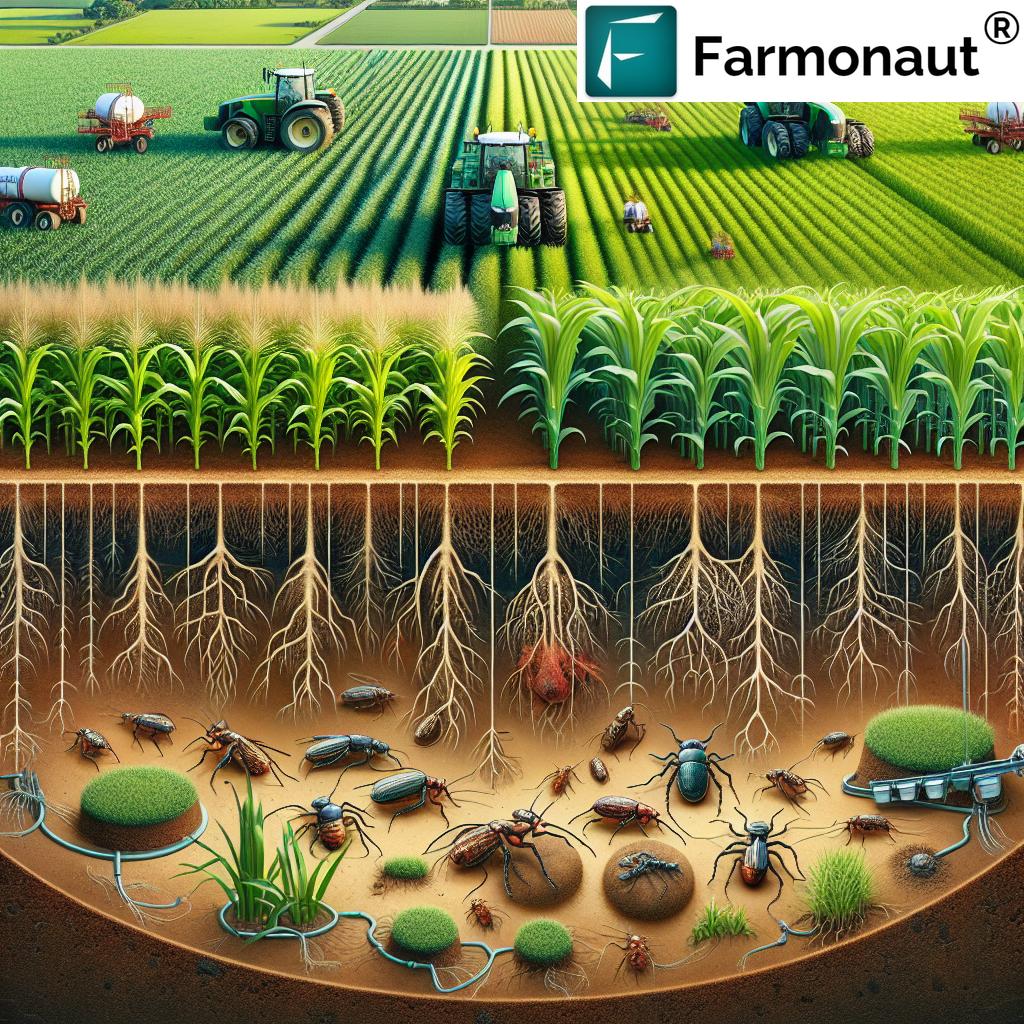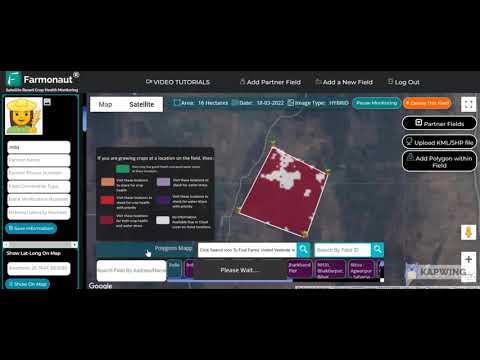Mastering Sugarcane Beetle Control: A Comprehensive Guide to Integrated Pest Management for Optimal Crop Yields
“Sugarcane beetles can reduce corn yields by up to 30% if left uncontrolled, highlighting the importance of effective pest management.”
Welcome to our comprehensive guide on sugarcane beetle control and integrated pest management (IPM) strategies. As experts in agricultural technology and sustainable farming practices, we at Farmonaut understand the critical challenges faced by farmers in protecting their crops from destructive pests. In this extensive field guide, we’ll explore effective methods to combat the sugarcane beetle, a persistent threat to crops such as corn, sugarcane, and turfgrass.
Our mission is to equip you with the knowledge and tools necessary to implement successful IPM techniques, optimize your crop yields, and promote sustainable agriculture. By combining traditional farming wisdom with cutting-edge precision agriculture technologies, we aim to revolutionize pest management practices for the modern farmer.
Understanding the Sugarcane Beetle: A Formidable Agricultural Pest
Before we delve into control strategies, it’s crucial to understand our adversary. The sugarcane beetle (Euetheola humilis), a member of the Scarabaeidae family, is a significant pest in various agricultural systems. These beetles pose a serious threat to crops, particularly in the southern United States, where they can cause extensive damage to corn, sugarcane, and turfgrass.
Life Cycle and Characteristics
- Adults: Measuring about 1/2 inch in length, adult sugarcane beetles are characterized by their dark brown to black color and robust bodies.
- Eggs: Female beetles lay white, oval-shaped eggs in the soil, typically near the roots of host plants.
- Larvae: Also known as grubs, the larvae are white with brown heads and curved bodies. They go through several instars as they develop.
- Pupae: The pupal stage occurs in the soil, where the insect undergoes its final transformation into an adult.
Understanding this life cycle is crucial for implementing effective control measures at the right time. The sugarcane beetle typically has one generation per year, with adults emerging in spring to mate and lay eggs.
Damage and Impact on Crops
Sugarcane beetles can wreak havoc on crops in several ways:
- Root Damage: Larvae feed on the roots of plants, weakening their structure and impeding nutrient uptake.
- Stem Boring: Adults can bore into the stems of young plants, causing them to wilt and die.
- Leaf Feeding: While less common, adults may also feed on leaves, reducing photosynthetic capacity.
The economic impact of sugarcane beetle infestations can be severe, with potential yield losses ranging from 10% to 30% in heavily affected areas. This underscores the importance of implementing robust pest management strategies to protect crop yields and farm profitability.

Integrated Pest Management: A Holistic Approach to Sugarcane Beetle Control
At Farmonaut, we advocate for an integrated pest management (IPM) approach to sugarcane beetle control. IPM combines various strategies to manage pest populations effectively while minimizing environmental impact and promoting sustainable farming practices. Let’s explore the key components of an effective IPM program for sugarcane beetles.
1. Monitoring and Scouting
The foundation of any successful IPM program is regular monitoring and scouting. We recommend:
- Conducting weekly field inspections during critical growth stages
- Using pheromone traps to monitor adult beetle populations
- Examining soil samples for the presence of larvae
- Utilizing Farmonaut’s satellite-based crop health monitoring to detect early signs of stress that may indicate pest presence
By leveraging Farmonaut’s advanced satellite imagery and AI-driven insights, farmers can identify potential problem areas before they escalate, allowing for targeted and timely interventions.
2. Cultural Control Methods
Cultural control practices play a crucial role in managing sugarcane beetle populations:
- Crop Rotation: Implementing a diverse crop rotation plan can disrupt the beetle’s life cycle and reduce population buildup.
- Tillage Practices: Fall plowing can expose larvae to predators and harsh weather conditions, reducing overwintering populations.
- Planting Dates: Adjusting planting dates to avoid peak beetle activity periods can minimize crop damage.
- Field Sanitation: Removing crop residues and managing weeds can eliminate potential beetle habitats.
These practices not only help control sugarcane beetles but also contribute to overall soil health and sustainable farming.
3. Biological Control
Encouraging natural enemies of the sugarcane beetle can provide effective, environmentally friendly pest control:
- Beneficial Nematodes: Certain species of nematodes can parasitize beetle larvae, reducing their populations.
- Predatory Insects: Ground beetles and other predatory insects feed on sugarcane beetle eggs and larvae.
- Birds: Many bird species prey on adult beetles, contributing to natural population control.
By creating habitats that support these natural enemies, farmers can establish a more balanced ecosystem that naturally suppresses pest populations.
4. Chemical Control
While we prioritize sustainable practices, chemical control may be necessary in cases of severe infestation. When using insecticides:
- Choose products specifically labeled for sugarcane beetle control
- Apply treatments at the most vulnerable stages of the beetle’s life cycle
- Follow all label instructions and safety precautions
- Rotate insecticide classes to prevent resistance development
It’s crucial to use chemical treatments judiciously and as part of a broader IPM strategy to minimize environmental impact and preserve beneficial insects.
Precision Agriculture Technologies for Enhanced Pest Management
At Farmonaut, we’re at the forefront of integrating precision agriculture technologies into pest management strategies. Our advanced tools can significantly enhance the effectiveness of your sugarcane beetle control efforts:
- Satellite-Based Crop Monitoring: Our platform provides real-time insights into crop health, allowing for early detection of pest-related stress.
- AI-Powered Advisory System: The Jeevn AI system offers personalized recommendations for pest management based on your specific field conditions.
- Precision Application Technologies: Use our data to guide targeted insecticide applications, reducing overall chemical usage while maximizing effectiveness.
By leveraging these technologies, farmers can make data-driven decisions, optimizing their pest management strategies and improving overall crop yields.
Explore Farmonaut’s API for advanced agricultural data integration
“Implementing integrated pest management techniques for sugarcane beetles can increase crop yields by 15-25% compared to conventional methods.”
Sustainable Farming Practices for Long-Term Pest Control
Effective sugarcane beetle management goes hand in hand with sustainable farming practices. By improving overall soil health and ecosystem balance, we can create an environment that’s naturally more resistant to pest infestations:
- Cover Cropping: Planting cover crops can improve soil structure, increase organic matter, and support beneficial insect populations.
- Reduced Tillage: Minimizing soil disturbance can preserve natural enemy populations and improve soil health.
- Nutrient Management: Proper fertilization ensures robust plant growth, making crops more resilient to pest damage.
- Water Conservation: Efficient irrigation practices not only conserve water but also create less favorable conditions for beetle reproduction.
These practices not only aid in pest control but also contribute to the overall sustainability and profitability of your farm.
Check out our API Developer Docs for integrating sustainable farming data
Pest-Resistant Crop Varieties: A Proactive Approach
Selecting pest-resistant crop varieties is a proactive strategy in the fight against sugarcane beetles. While no variety is completely immune, some exhibit stronger resistance to beetle damage:
- Corn: Varieties with stronger stalks and more extensive root systems can better withstand beetle attacks.
- Sugarcane: Some cultivars show increased tolerance to root feeding damage.
- Turfgrass: Certain grass species and cultivars are less attractive to sugarcane beetles.
Consult with local agricultural extension services or use Farmonaut’s AI advisory system to identify the best pest-resistant varieties for your specific region and conditions.

The Role of Weather and Climate in Sugarcane Beetle Management
Understanding the relationship between weather patterns and sugarcane beetle activity is crucial for effective pest management. Climate factors significantly influence beetle populations and their potential for crop damage:
- Temperature: Warmer temperatures can accelerate beetle development and increase the number of generations per year.
- Rainfall: Excessive moisture can promote larval survival, while drought conditions may drive adult beetles to seek out irrigated crops.
- Soil Moisture: Optimal soil moisture levels are crucial for egg-laying and larval development.
Farmonaut’s platform integrates real-time weather data and forecasts, allowing farmers to anticipate potential beetle outbreaks and adjust their management strategies accordingly.
Economic Considerations in Sugarcane Beetle Management
Implementing an effective sugarcane beetle management program requires careful economic consideration. While the upfront costs of IPM strategies may seem higher, they often result in long-term savings and increased profitability:
- Cost-Benefit Analysis: Evaluate the potential yield gains against the costs of various control methods.
- Threshold-Based Treatments: Establish economic thresholds for beetle populations to guide treatment decisions.
- Long-Term Investment: Consider the long-term benefits of sustainable practices in reducing pest pressure over time.
Farmonaut’s platform can help you track and analyze the economic impacts of your pest management strategies, allowing for data-driven decision-making to maximize your return on investment.
Collaborative Approaches to Sugarcane Beetle Management
Effective pest management often requires a collaborative effort. We encourage farmers to:
- Participate in community-wide pest monitoring programs
- Share data and experiences with neighboring farms
- Engage with local agricultural extension services for support and guidance
- Utilize Farmonaut’s platform to connect with experts and share insights
By working together, we can develop more comprehensive and effective strategies for managing sugarcane beetle populations across entire agricultural regions.
The Future of Sugarcane Beetle Control: Emerging Technologies and Research
As we look to the future, several promising technologies and research areas are emerging in the field of sugarcane beetle management:
- Gene Editing: CRISPR technology may lead to the development of more pest-resistant crop varieties.
- Pheromone Disruption: Advanced pheromone technologies could disrupt beetle mating cycles on a large scale.
- Microbial Control Agents: New strains of beneficial microorganisms may offer enhanced biological control options.
- Nanotechnology: Nano-formulations of pesticides could improve efficacy while reducing environmental impact.
At Farmonaut, we’re committed to staying at the forefront of these developments, integrating new technologies into our platform to provide farmers with the most advanced pest management tools available.
Conclusion: Empowering Farmers for Successful Sugarcane Beetle Management
Mastering sugarcane beetle control is a complex but achievable goal. By implementing a comprehensive IPM strategy that combines traditional wisdom with cutting-edge technologies, farmers can effectively manage this persistent pest while promoting sustainable agriculture practices.
Remember, successful pest management is an ongoing process that requires vigilance, adaptability, and a commitment to continuous learning. With the right tools, knowledge, and support, you can protect your crops, optimize your yields, and build a more resilient and profitable farming operation.
At Farmonaut, we’re dedicated to supporting farmers in this journey. Our advanced satellite-based monitoring systems, AI-powered advisory tools, and comprehensive data analytics platform are designed to give you the insights and capabilities you need to stay ahead of pest challenges and maximize your agricultural success.
Comparison of Sugarcane Beetle Control Methods
| Control Method | Effectiveness Rating (1-5) | Environmental Impact (1-5) | Cost Estimate | Implementation Difficulty (1-5) |
|---|---|---|---|---|
| Chemical Control | 4 | 4 | High | 2 |
| Biological Control | 3 | 1 | Medium | 3 |
| Cultural Practices | 3 | 1 | Low | 4 |
| Precision Agriculture Technologies | 5 | 2 | High | 4 |
Frequently Asked Questions (FAQ)
- Q: How can I identify a sugarcane beetle infestation in my crops?
A: Look for signs such as wilting plants, stunted growth, and irregular patches in your fields. You may also notice adult beetles near plant bases or find C-shaped grubs in the soil when digging. - Q: What is the best time to implement control measures for sugarcane beetles?
A: The most effective time is usually in early spring before adult beetles emerge. However, monitoring throughout the growing season is crucial for timely interventions. - Q: Are there any natural predators of sugarcane beetles that I can encourage in my fields?
A: Yes, ground beetles, birds, and certain parasitic wasps are natural predators. Creating diverse habitats around your fields can help attract these beneficial organisms. - Q: How does crop rotation help in managing sugarcane beetle populations?
A: Crop rotation disrupts the beetle’s life cycle by removing their preferred host plants. Rotating with non-host crops can significantly reduce beetle populations over time. - Q: Can Farmonaut’s satellite monitoring detect sugarcane beetle infestations?
A: While our satellite monitoring can’t directly detect beetles, it can identify areas of crop stress that may indicate pest presence, allowing for targeted scouting and early intervention.






